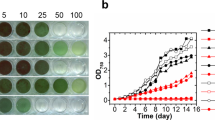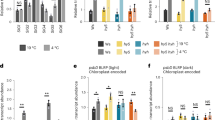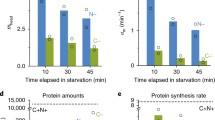Abstract
Adaptation of Escherichia coli at low temperature implicates a drastic reprogramming of gene expression patterns. Mechanisms operating downstream of transcription initiation, such as control of transcription termination, mRNA stability and translatability, play a major role in controlling gene expression in the cold acclimation phase. It was previously shown that Rho-dependent transcription termination within pnp, the gene encoding polynucleotide phosphorylase (PNPase), was suppressed in pnp nonsense mutants, whereas it was restored by complementation with wild type allele. Using a tRNA gene as a reporter and the strong Rho-dependent transcription terminator t imm of bacteriophage P4 as a tester, here we show that specific sites in the 5′-untranslated region of pnp mRNA are required for PNPase-sensitive cold-induced suppression of Rho-dependent transcription termination. We suggest that suppression of Rho-dependent transcription termination within pnp and its restoration by PNPase is an autogenous regulatory circuit that modulates pnp expression during cold acclimation.




Similar content being viewed by others
References
Alifano P, Rivellini F, Limauro D, Bruni CB, Carlomagno MS (1991) A consensus motif common to all Rho-dependent prokaryotic transcription terminators. Cell 64:553–563
Artsimovitch I, Landick R (2002) The transcriptional regulator RfaH stimulates RNA chain synthesis after recruitment to elongation complexes by the exposed nontemplate DNA strand. Cell 109:193–203
Bae W, Phadtare S, Severinov K, Inouye M (1999) Characterization of Escherichia coli cspE, whose product negatively regulates transcription of cspA, the gene for the major cold shock protein. Mol Microbiol 31:1429–1441
Bae W, Xia B, Inouye M, Severinov K (2000) Escherichia coli CspA-family RNA chaperones are transcription antiterminators. Proc Natl Acad Sci USA 97:7784–7789
Baklanov MM, Golikova LN, Malygin EG (1996) Effect on DNA transcription of nucleotide sequences upstream to T7 promoter. Nucleic Acids Res 24:3659–3660
Banerjee S, Chalissery J, Bandey I, Sen R (2006) Rho-dependent transcription termination: more questions than answers. J Microbiol 44:11–22
Bear DG, Hicks PS, Escudero KW, Andrews CL, McSwiggen JA, von Hippel PH (1988) Interactions of Escherichia coli transcription termination factor rho with RNA. II. Electron microscopy and nuclease protection experiments. J Mol Biol 199:623–635
Beran RK, Simons RW (2001) Cold-temperature induction of Escherichia coli polynucleotide phosphorylase occurs by reversal of its autoregulation. Mol Microbiol 39:112–125
Berlyn MKB (1998) Linkage map of Escherichia coli K-12, Edition 10: the traditional map. Microbiol Mol Biol Rev 62:814–984
Briani F, Zangrossi S, Ghisotti D, Dehò G (1996) A Rho-dependent transcription termination site regulated by bacteriophage P4 RNA immunity factor. Virology 223:57–67
Briani F, Del Favero M, Capizzuto R, Consonni C, Zangrossi S, Greco C, De Gioia L, Tortora P, Dehò G (2007) Genetic analysis of polynucleotide phosphorylase structure and functions. Biochimie 89:145–157
Ciampi MS (2006) Rho-dependent terminators and transcription termination. Microbiology 152:2515–2528
Condon C, Squires C, Squires CL (1995) Control of rRNA transcription in Escherichia coli. Microbiol Rev 59:623–645
Das A, Court D, Adhya S (1976) Isolation and characterization of conditional lethal mutants of Escherichia coli defective in transcription termination factor rho. Proc Natl Acad Sci USA 73:1959–1963
Dehò G, Zangrossi S, Sabbattini P, Sironi G, Ghisotti D (1992) Bacteriophage P4 immunity controlled by small RNAs via transcription termination. Mol Microbiol 6:3415–3425
Dodd IB, Shearwin KE, Egan JB (2005) Revisited gene regulation in bacteriophage lambda. Curr Opin Genet Dev 15:145–152
García Mena J, Das A, Sanchez-Trujillo A, Portier C, Montanez C (1999) A novel mutation in the KH domain of polynucleotide phosphorylase affects autoregulation and mRNA decay in Escherichia coli. Mol Microbiol 33:235–248
Ghisotti D, Chiaramonte R, Forti F, Zangrossi S, Sironi G, Dehò G (1992) Genetic analysis of the immunity region of phage-plasmid P4. Mol Microbiol 6:3405–3413
Gibson TJ, Thompson JD, Heringa J (1993) The KH domain occurs in a diverse set of RNA-binding proteins that include the antiterminator NusA and is probably involved in binding to nucleic acid. FEBS Lett 324:361–366
Goldstein J, Pollitt NS, Inouye M (1990) Major cold shock protein of Escherichia coli. Proc Natl Acad Sci USA 87:283–287
Gualerzi CO, Giuliodori AM, Pon CL (2003) Transcriptional and post-transcriptional control of cold-shock genes. J Mol Biol 331:527–539
Henkin TM, Yanofsky C (2002) Regulation by transcription attenuation in bacteria: how RNA provides instructions for transcription termination/antitermination decisions. Bioessays 24:700–707
Herendeen SL, VanBogelen RA, Neidhardt FC (1979) Levels of major proteins of Escherichia coli during growth at different temperatures. J Bacteriol 139:185–194
Hinde P, Deighan P, Dorman CJ (2005) Characterization of the detachable Rho-dependent transcription terminator of the fimE gene in Escherichia coli K-12. J Bacteriol 187:8256–8266
Ingraham JL, Marr AG (1996) Effect of temperature, pressure, pH, and osmotic stress on growth. In: Neidhardt FC (ed) Escherichia coli and Salmonella: cellular and molecular biology. American Society for Microbiology, Washington, DC pp 1570–1577
Jager S, Fuhrmann O, Heck C, Hebermehl M, Schiltz E, Rauhut R, Klug G (2001) An mRNA degrading complex in Rhodobacter capsulatus. Nucleic Acids Res 29:4581–4588
Jarrige AC, Mathy N, Portier C (2001) PNPase autocontrols its expression by degrading a double-stranded structure in the pnp mRNA leader. EMBO J 20:6845–6855
Jiang W, Hou Y, Inouye M (1997) CspA, the major cold-shock protein of Escherichia coli, is an RNA chaperone. J Biol Chem 272:196–202
Jones PG, Mitta M, Kim Y, Jiang W, Inouye M (1996) Cold shock induces a major ribosomal-associated protein that unwinds double-stranded RNA in Escherichia coli. Proc Natl Acad Sci USA 93:76–80
Jones PG, VanBogelen RA, Neidhardt FC (1987) Induction of proteins in response to low temperature in Escherichia coli. J Bacteriol 169:2092–2095
Littauer UZ (2005) From polynucleotide phosphorylase to neurobiology. J Biol Chem 280:38889–38897
Lopez PJ, Iost I, Dreyfus M (1994) The use of a tRNA as a transcriptional reporter: the T7 late promoter is extremely efficient in Escherichia coli but its transcripts are poorly expressed. Nucleic Acids Res 22:1186–1193
Luttinger A, Hahn J, Dubnau D (1996) Polynucleotide phosphorylase is necessary for competence development in Bacillus subtilis. Mol Microbiol 19:343–356
Marcaida MJ, Depristo MA, Chandran V, Carpousis AJ, Luisi BF (2006) The RNA degradosome: life in the fast lane of adaptive molecular evolution. Trends Biochem Sci 31:359–365
McClain WH, Foss K, Jenkins RA, Schneider J (1991) Rapid determination of nucleotides that define tRNA(Gly) acceptor identity. Proc Natl Acad Sci USA 88:6147–6151
Mohanty BK, Kushner SR (2000a) Polynucleotide phosphorylase functions both as a 3′ > 5′ exonuclease and a poly(A) polymerase in Escherichia coli. Proc Natl Acad Sci USA 97:11966–11971
Mohanty BK, Kushner SR (2000b) Polynucleotide phosphorylase, RNase II and RNase E play different roles in the in vivo modulation of polyadenylation in Escherichia coli. Mol Microbiol 36:982–994
Morgan WD, Bear DG, Litchman BL, von Hippel PH (1985) RNA sequence and secondary structure requirements for rho-dependent transcription termination. Nucleic Acids Res 13:3739–3754
Ng H, Ingrahm JL, Mitta M (1962) Damage and derepression in Escherichia coli resulting from growth at low temperatures. J Bacteriol 84:331–339
Phadtare S, Alsina J, Inouye M (1999) Cold-shock response and cold-shock proteins. Curr Opin Microbiol 2:175–180
Phadtare S, Inouye M, Severinov K (2002) The nucleic acid melting activity of Escherichia coli CspE is critical for transcription antitermination and cold acclimation of cells. J Biol Chem 277:7239–7245
Piazza F, Zappone M, Sana M, Briani F, Dehò G (1996) Polynucleotide phosphorylase of Escherichia coli is required for the establishment of bacteriophage P4 immunity. J Bacteriol 178:5513–5521
Portier C, Dondon L, Grunberg Manago M, Régnier P (1987) The first step in the functional inactivation of the Escherichia coli polynucleotide phosphorylase messenger is a ribonuclease III processing at the 5′ end. EMBO J 6:2165–2170
Prud’homme-Généreux A, Beran RK, Iost I, Ramey CS, Mackie GA, Simons RW (2004) Physical and functional interactions among RNase E, polynucleotide phosphorylase and the cold-shock protein, CsdA: evidence for a ‘cold shock degradosome’. Mol Microbiol 54:1409–1421
Régnier P, Portier C (1986) Initiation, attenuation and RNase III processing of transcripts from the Escherichia coli operon encoding ribosomal protein S15 and polynucleotide phosphorylase. J Mol Biol 187:23–32
Régnier P, Grunberg Manago M, Portier C (1987) Nucleotide sequence of the pnp gene of Escherichia coli encoding polynucleotide phosphorylase. Homology of the primary structure of the protein with the RNA-binding domain of ribosomal protein S1. J Biol Chem 262:63–68
Regonesi ME, Briani F, Ghetta A, Zangrossi S, Ghisotti D, Tortora P, Dehò G (2004) A mutation in polynucleotide phosphorylase from Escherichia coli impairing RNA binding and degradosome stability. Nucleic Acids Res 32:1006–1017
Regonesi ME, Del Favero M, Basilico F, Briani F, Benazzi L, Tortora P, Mauri P, Dehò G (2006) Analysis of the Escherichia coli RNA degradosome composition by a proteomic approach. Biochimie 88:151–161
Reiner AM (1969a) Characterization of polynucleotide phosphorylase mutants of Escherichia coli. J Bacteriol 97:1437–1443
Reiner AM (1969b) Isolation and mapping of polynucleotide phosphorylase mutants of Escherichia coli. J Bacteriol 97:1431–1436
Robert-Le Meur M, Portier C (1992) E. coli polynucleotide phosphorylase expression is autoregulated through an RNase III-dependent mechanism. EMBO J 11:2633–2641
Robert-Le Meur M, Portier C (1994) Polynucleotide phosphorylase of Escherichia coli induces the degradation of its RNase III processed messenger by preventing its translation. Nucleic Acids Res 22:397–403
Sasaki I, Bertani G (1965) Growth abnormalities in Hfr derivatives of Escherichia coli strain C. J Gen Microbiol 40:365–376
Sloan SB, Weisberg RA (1993) Use of a gene encoding a suppressor tRNA as a reporter of transcription: analyzing the action of the Nun protein of bacteriophage HK022. Proc Natl Acad Sci USA 90:9842–9846
Symmons MF, Jones GH, Luisi BF (2000) A duplicated fold is the structural basis for polynucleotide phosphorylase catalytic activity, processivity, and regulation. Struct Fold Des 8:1215–1226
Torres M, Balada JM, Zellars M, Squires C, Squires CL (2004) In vivo effect of NusB and NusG on rRNA transcription antitermination. J Bacteriol 186:1304–1310
Vicari D, Artsimovitch I (2004) Virulence regulators RfaH and YaeQ do not operate in the same pathway. Mol Genet Genomics 272:489–496
Wang N, Yamanaka K, Inouye M (1999) CspI, the ninth member of the CspA family of Escherichia coli, is induced upon cold shock. J Bacteriol 181:1603–1609
Weber MHW, Marahiel MA (2003) Bacterial cold shock responses. Sci Prog 86:9–75
Yamanaka K, Fang L, Inouye M (1998) The CspA family in Escherichia coli: multiple gene duplication for stress adaptation. Mol Microbiol 27:247–255
Zangrossi S, Briani F, Ghisotti D, Regonesi ME, Tortora P, Dehò G (2000) Transcriptional and post-transcriptional control of polynucleotide phosphorylase during cold acclimation in Escherichia coli. Mol Microbiol 36:1470–1480
Zuker M, Mathews D, Turner D (1999) Algorithms and thermodynamics for RNA secondary structure prediction: a practical guide. In: Barciszewski J, Clark B (eds) RNA biochemistry and biotechnology. Kluwer, Dordrecht, pp 11–43
Acknowledgments
This research was supported by joint grants from the Ministero dell’Istruzione, dell’Università e della Ricerca and Università degli Studi di Milano (PRIN 2003, PRIN 2005, and FIRB 2001).
Author information
Authors and Affiliations
Corresponding author
Additional information
Communicated by D. Andersson.
Rights and permissions
About this article
Cite this article
Marchi, P., Longhi, V., Zangrossi, S. et al. Autogenous regulation of Escherichia coli polynucleotide phosphorylase during cold acclimation by transcription termination and antitermination. Mol Genet Genomics 278, 75–84 (2007). https://doi.org/10.1007/s00438-007-0231-3
Received:
Accepted:
Published:
Issue Date:
DOI: https://doi.org/10.1007/s00438-007-0231-3




